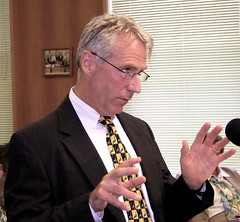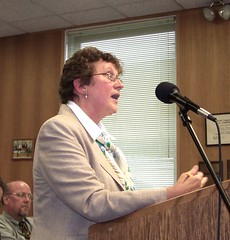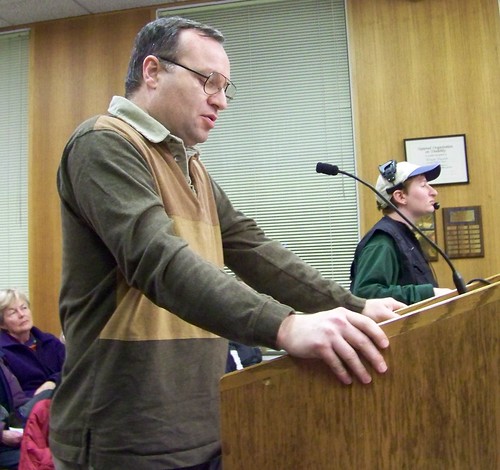The Northampton Department of Public Works is seeking to significantly expand its 39-acre regional landfill, located off Glendale Road. The plan--known as Phase 5/Phase 5B-- would add approximately 20 acres to the north, and another 10 acres piggybacked on the side slopes of the current site. The expansion is designed to add another 20 years to the lifespan of the facility, based upon a fill rate of 50,000 tons per year. If the City of Northampton does nothing, the current site will reach capacity in 2-3 years.

DPW Chief Ned Huntley and City Engineer Jim Laurila at a recent Board of Public Works meeting
The landfill has been in operation since 1969. The original unlined landfill covers a 21-acre area, which stopped accepting waste in 1990 and was capped in 1995. Just to the east of the unlined landfill are four lined cells, referred to as Phases 1-4.
An opposition group called "Citizens United for a Healthy Future" (click here for an audio interview with Jo-Anne Besette and Linda Heisiger of Citizens United) maintains a website at www.savingparadise.info. While Citizens United point to problems that they see with the current landfill, such as odor, noise, and the pollution of the Hannum Brook, a tributary of the Manhan River that borders the landfill property, their primary focus is on stopping the proposed landfill expansion.
A Zone II aquifer recharge area is defined as "that area of an aquifer that contributes water to a well under the most severe pumping conditions that can be reasonably anticipated."
In 1999 the Department of Environmental Protection (DEP) determined that the Glendale Road landfill is indeed situated over the Zone II area for the Maloney Well, a backup drinking water supply for the neighboring city of Easthampton. In order to proceed with the Phase 5/Phase 5B expansion, the City of Northampton applied for--and, in 2006, was granted--a waiver of the DEP's siting criteria that prohibit landfill development within Zone II areas.
Citizens United argues that the expansion should not go forward, and that the DEP should not have granted this waiver. Their members have spoken at numerous city council meetings with the message that landfill liners will inevitably leak, and in an era of dwindling water resources, we should be uncompromising in protecting of what we have. Massachusetts state environmental regulations prohibit siting landfills over Zone II areas. Why was the waiver granted? In private conversations, citizens from the Glendale Road neighborhood have wondered if the DEP's decision was based upon politics instead of science.
The Contaminant Transport Model: A Key Document
The contaminant transport model commissioned by the City was an important part of Northampton's application to the DEP for a positive site suitability report. Laurila explained to me that the model was designed using extremely conservative parameters--for example, it assumed a poorly constructed single composite liner, when in fact, the design calls for a carefully-constructed double composite liner with a 12-inch leak detection zone. Four compounds--zinc, manganese, methylene chloride, and a theoretical, non-reactive, non-adsorptive compound--were modeled at concentrations much higher than those present in Northampton leachate. (The theoretical compound was included to estimate dilution effects, and to determine how a fast-moving compound that is neither impeded by soils nor chemical transformation will travel through the aquifer, hence contributing, according to Laurila and Huntley, to the model's conservative assumptions.)
A "catastrophic release" of leachate was posited, and combined with the assumption of chronic liner leakage. The model was run from 50-100 years, and assumed that no capping would be present.
The model, when ran, predicted that even in the case of a catastrophic leachate release at the landfill, there would be no impact on the Maloney Well. "Near total dilution" would occur by the time water from the landfill reached the well. These findings are summarized in a September 2007 DPW memo to the City Council entitled "Background Information--Proposed Landfill Expansion and Maloney Well Aquifer."
The contaminant transport model was prepared by Dufresne-Henry (which became Stantec Engineering) in collaboration with Dr. Peter Shanahan of HydroAnalysis, Inc. The draft contaminant transport model, which can be viewed at the Forbes Library as an appendix to the September 2005 Draft Environmental Impact Report (DEIR), was signed by Mr. Laurila, who worked for Dufresne-Henry and Stantec before taking his position with the City of Northampton.
If the contaminant transport model is valid, this undermines the position of anti-landfill activists who assert that the Maloney Well will be compromised by the expansion. But if the model is weak or flawed, or if inadequate independent review of the model can be demonstrated, then the Maloney Well argument stands strong.
Ned Huntley, Director of the Department of Public Works, points out in the September 2007 DPW memo that the groundwater flow model (upon which the contaminant transport model was based) was developed in collaboration with the DEP, was approved by the DEP, and was independently reviewed by the City of Easthampton, in consultation with SEA Consultants, at the expense of the Northampton DPW. Dufresne-Henry revised the groundwater flow model when SEA and the City of Easthampton provided additional information on the aquifer. According to the memo, Dr. Robert Newton, a Smith College professor and hydrogeologist who sits on the Barnes Aquifer Protection Advisory Committee (BAPAC), was invited by the DPW to review an early draft of the groundwater flow model, but that "other commitments prevented him from having time to commit to model development."
Huntley and Laurila also note that no comments regarding the draft contaminant transport model were submitted to MEPA during the public comment phase of the Draft Environmental Impact Report (DEIR). While Clean Water Action and Toxic Action Center requested copies of the DEIR, neither organization submitted comment.
The groundwater flow model was approved by the DEP in 2005. The final contaminant transport model was approved by the DEP in 2006 as part of the positive Site Suitability Report.
(For Audio/Video of Dr. Robert Newton's objections to the proposed landfill expansion, click here.)
Challenges to the Contaminant Transport Model
In November of 2007, the Easthampton City Council sent a letter to Laurie Burt, Commissioner of the Department of Environmental Protection, asking that she reconsider the site selection waiver. The letter references "two other unstudied, unlined landfills" in Easthampton, no longer in use, that "lie over the same aquifer" and maintains that the cumulative effect of leachate from all three sites should be incorporated into the model.
All parties agree that the well is not pristine, and is already marked by borderline-high manganese and iron levels. The Easthampton city council's letter maintains that the transport model assumes a pristine aquifer, and that any addition of iron or manganese would push water quality past the tipping point defined by MMCL (Massachusetts Maximum Contaminant Levels.)
But months earlier, in a June 11, 2007 letter, Easthampton Mayor Michael Tautznik had presented this exact argument, as promulgated by professor Robert Newton, to Northampton Mayor Clare Higgins. Higgins passed the letter on to DPW chief Huntley, who responded that "Dr. Newton's contention that the inclusion of the closed landfills at Oliver Street and Loudville Road would significantly alter the predicted concentrations at the Maloney Well is not valid for two main reasons," and goes on to explain that the Loudville Road Landfill is located over a clay confining layer which isolates it from the aquifer, and that the Oliver Street Landfill is partially isolated by the same clay layer.
Huntley added that even were the two Easthampton landfills deemed to be contributors, that that would not alter the contribution of the Northampton landfill--the contaminant transport model demonstrated "near total attenuation" between the landfill and the well, and the "existence of other potential sources . . . does not alter this basic finding." Huntley invited Tautznik, his staff, and Dr. Newton to meet for further discussion, and expressed willingness to alter the assumptions in the model if presented with useful information. Huntley's letter did not address the assertion that the model falsely assumes pristine conditions at the Maloney Well. Robert Newton did not respond to my request for comment.
Can A Public, Televised Scientists' Debate Be Organized?
Few individuals are truly qualified to judge the validity and veracity of such a specialized scientific model. Laypeople might reasonable ask a number of questions, however. For instance, does the posited catastrophic event--based upon a two-day leak in the force main releasing 154,000 gallons of leachate-- really represent the worst possible scenario? Do the four chemicals chosen accurately represent all potential groundwater threats from the landfill? What about arsenic, for example, which is not present in leachate, but is mobilized from the rocks and soil by anoxic (low dissolved oxygen) water-based solutions, such as leachate? Do we really have enough geological information to accurately model groundwater flow in the Barnes Aquifer at all?
Much of downtown Easthampton is located over the Zone II recharge area for the Maloney Well, and the well itself is already high in iron and manganese, two elements that are also mobilized by anoxic groundwater conditions. Is the City of Northampton, and the Commonwealth of Massachusetts, making a decision that we, in the interest of providing an important public utility, can risk sacrificing this well, which after all, is not the primary source of water for Easthampton, and which would already require treatment were it to be deployed?
And even if the contaminant transport model were deemed to be valid, is that really the only environmental consideration? What about the pollution of the Hannum Brook, which borders the landfill property--is this pollution attributable only to the old, unlined landfill, or can we expect more of the same from an improved facility? See Fred Contrada's article in The Republican.
And, even if the City's science is irrefutable, is expanding the landfill the best and only option for dealing with our regional solid waste?
Clearly, a debate among qualified scientists is in order. Stay tuned...We'll keep our ear to the ground. Even if the City Council continues to refuse to sponsor debate on this issue, the Board of Public Works may well step up to the plate and work cooperatively with citizens' groups to ensure that all issues have a fair and comprehensive hearing.
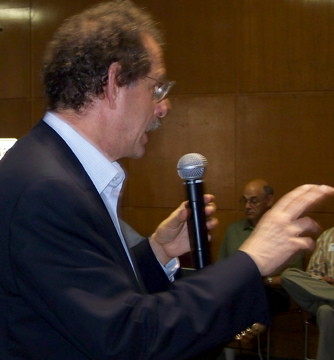 Photo: Howard Schneider, Dean of the Journalism Department at Stony Brook University in New York and former reporter and managing editor with Newsday.
Photo: Howard Schneider, Dean of the Journalism Department at Stony Brook University in New York and former reporter and managing editor with Newsday.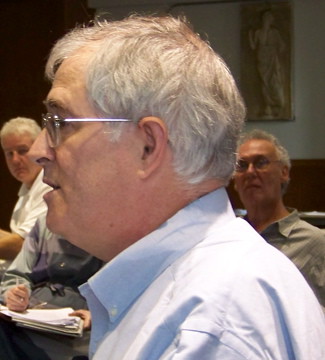 Photo: Doug McGill, Journalism professor at Carleton College, former New York Times staff reporter and International Bureau Chief with Bloomberg News
Photo: Doug McGill, Journalism professor at Carleton College, former New York Times staff reporter and International Bureau Chief with Bloomberg News